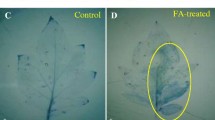Abstract
γ-Ray irradiation of pre-sowing seeds of tomato did not trigger the formation of the phytoalexin “rishitin” in either leaves or fruits of tomato plants through different growth seasons. Application of copper sulfate initiated rishitin formation in both leaves and fruits. Increasing of γ-ray dose was accompanied by decreasing rishitin accumulation in the presence of copper sulfate. Rishitin of tomato leaves was found to be reduced significantly, concomitant with increasing the disease incidence for late and early blight, andFusarium wilt disease, after applying γ-irradiation, in the case of biotic initiatorsPhytophthora infestans, Alternaria solani orFusarium oxysporum alone or together with the abiotic inducer copper sulfate. Shelf-extending γ-ray doses of 1.0, 1.5 and 2.0 kGy decreased rishitin amounts in tomato fruits treated with copper sulfate alone or infected withPhytophthora infestans. Also, the amount of formed rishitin was reduced by extending the storage period.
Similar content being viewed by others
References
Abdel-Khader A.S., Morris L.L., Maxie E.C.: Physiological studies of gamma irradiated tomato fruits. II. Effect on deterioration and shelf-life.Proc. Amer. Soc. Hort. Sci.,93, 831 (1968).
Abou El-Hawa M.E., Waffa Risk M., Sawsan M.E.: Feasible improvement for field and chocolate spot disease resistance in faba bean (Vicia faba) through phytoalexin initiation and accumulation by gamma irradiation combined with ironfolia application.Egypt. J. Appl. Sci. 8, 2 (1993).
Bailey J.A., Klarman W.L.: Toxicity of phytoalexins.Am. Appl. Biol. 89, 354–358 (1980).
Butler E.E., Webster I.K., Eokert N.W.: Taxonomy, pathogenecity and physiological properties of the fungus causing sour root of citrus.Phytopathology 55, 1262–1268 (1965).
Cruickshank I.A.M., Perrin D.R.: Phytoalexins of the leguminosae, phaseollin, fromPhaseolus vulgaris L.Life Sci. 2, 680–682 (1963).
El-Sayed S.A., Abou El-Hawa M.E.: Induced resistance and phytoalexin accumulation in biological control of early blight disease for tomato plants by gamma-irradiation and growth regulators.Egypt. J. Appl. Sci. 8, 1–12 (1993).
Hadwiger L.A., Sander C., Eddyrean N., Ralston J.: Sodium azide-induced mutants of peas that accumulate pisatin.Phytopathology 66, 629–630 (1976).
Hansen H.N.: A simple method of obtaining single spore cultures.Science 64, 384 (1926).
Laks P.E., Pruiner M.S.: Flavonoid biocides: Structure-activity relations of flavonoid phytoalexin analogues.Phytochemistry 28, 87–91 (1989).
Mansfield J.W., Porter A.E.A., Smallman R.V.: Dihydrowyerone derivatives as components of the furanoacetylenic phytoalexin response of tissues ofVicia faba.Phytochemistry 19, 1057–1061 (1980).
Metlitskii L.V., Ozeretskovskaya O.L.:Plant Immunity, Biochemical Aspects of Plant Resistance to Parasitic Fungi. Plenum Press, New York 1968.
Pare P.W., Dmitrieva N., Mabry T.J.: Phytoalexin aurone induced inCephalocereus senilis liquid suspension culture.Phytochemistry 30, 1133–1135 (1991).
Radov V., Ben-Yehoshua S., Kim J., Shapiro B., Ittah Y.: Ultraviolet illumination induces scoparone production in Kumquat and orange fruits and improves decay resistance.J. Amer. Soc. Hort. Sci. 117, 788–792 (1992).
Snedecor G.W.:Statistical Methods. Iowa State College Press, Iowa 1967.
Tomiyama K., Sakuma T., Ishizaka N., Sato N., Katshu N., Tokasugi M., Masamune T.: A new antifungal substance isolated from resistant potato tuber tissue infected by pathogens.Phytopathology 58, 115–116 (1968).
Yoshikawa M.: Diverse modes of action of biotic and abiotic phytoalexin elicitors.Nature 275, 546–547 (1978).
Author information
Authors and Affiliations
Rights and permissions
About this article
Cite this article
Ahmed, E.S., El-Essaway, A.A., Abou El-Hawa, M.E. et al. Biotic and abiotic initiators for rishitin formation and accumulation in tomato. Folia Microbiol 42, 468–472 (1997). https://doi.org/10.1007/BF02826555
Received:
Revised:
Issue Date:
DOI: https://doi.org/10.1007/BF02826555




